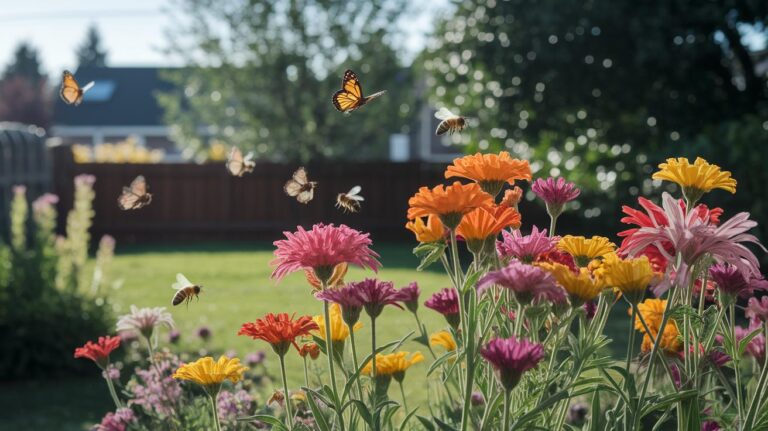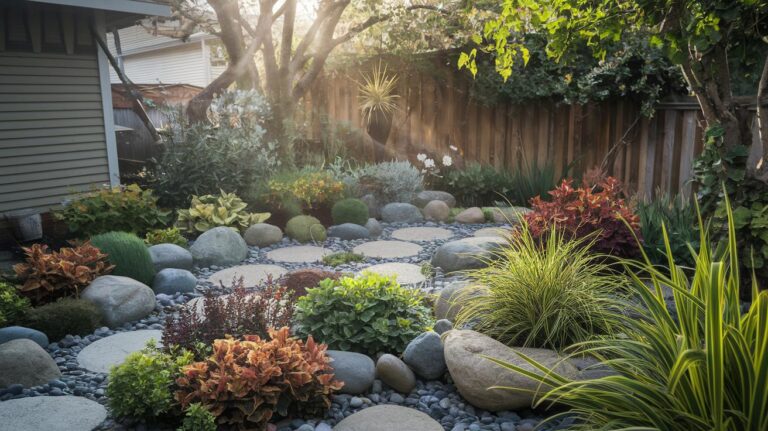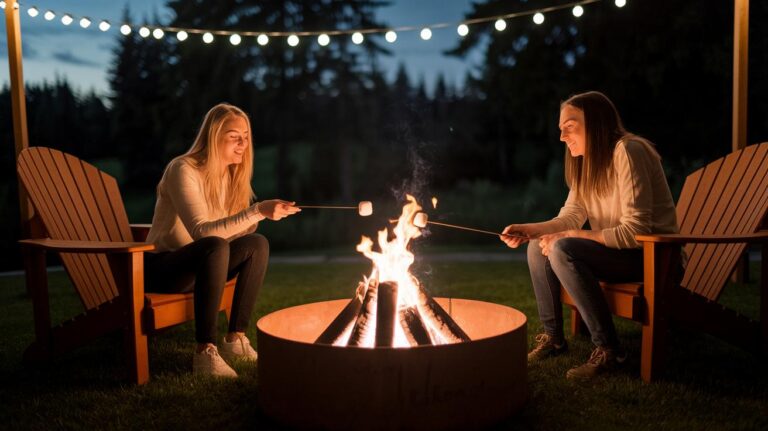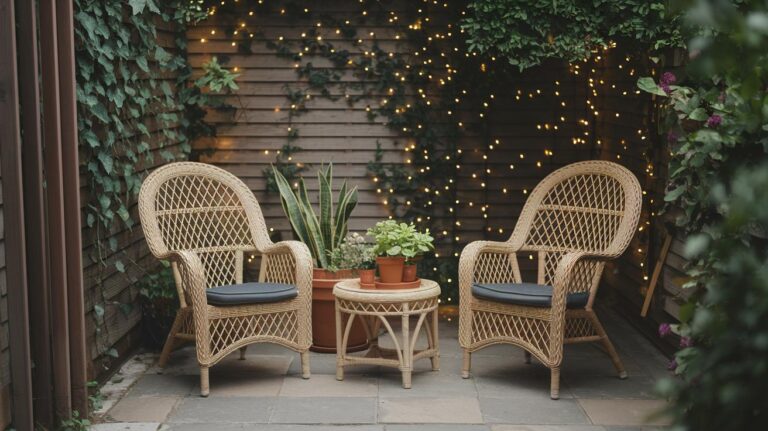Vertical Garden Design For Patio Walls Absolutely Amazing
Think your patio wall’s doomed to stay blah? It doesn’t have to be. Picture sitting in your favorite chair as a green waterfall of vines tickles the warm bricks.
Turning bare walls into living artwork saves precious floor space. It also brings friendly birds and buzzing bees right to your back door.
Here’s the fun part. Attach a wire grid (a frame with square openings) to your wall, then clip on fabric pouches (small cloth pockets for plants). Lean a wooden pallet (flat wood boards) nearby, and add a few odd shapes like old buckets or tin troughs. Before you know it, you’ll have a jaw-dropping vertical garden that’s easy, space-smart, and totally you.
Structural and Layout Inspiration for Patio Wall Vertical Gardens
Have you ever stared at a blank patio wall and wished it could burst into green life? Turning a dull concrete or brick face into a living canvas is easier than you think. With a little planning, you’ll save floor space and pack in more leafy goodness. Every inch counts when your patio is tight.
So let’s start with modular panel systems. These grids mount right on rails and hold rows of pockets or trays. You can swap pieces out whenever you want. The clean lines give your wall a neat, modern feel. And bright leaves really pop against that crisp framework.
Then there are pocket planters made from felt or fabric. Each pouch holds compost (rotted plant bits that feed soil) and gives roots a snug, moisture-loving home. These soft systems bend to fit odd shapes and curves, perfect for walls with quirks. Oops, spilled a bit of mix there? No worries, it’s all part of the fun.
Wooden pallets and wall-mounted planter boxes add a warm touch. Pallets stack tiered plant beds you fill with rich soil. Sturdy boxes screw right into studs and hold bigger pots. By the way, my cat naps on the bottom shelf most afternoons. Back to gardening, these setups are rock solid and need almost no extra gear.
Feeling artsy? Try triangles, hexagons, or squares for a geometric garden. Group pots in honeycomb clusters or step boxes in diagonal lines. You’ll guide the eye up and across, revealing new textures and colors at every level.
And don’t forget vines. Let ivy tendrils weave through panels and trailing herbs spill over edges. Plant taller greenery at the top and softer leaves below for a sculpted look. Your wall will feel like it’s breathing.
Mixing systems adds even more depth. Tuck a pallet corner into a panel setup or line pockets beside boxes for an offset grid. It’s like fitting puzzle pieces together. Before you know it, even the tiniest wall looks like a full garden.
Selecting the Best Plants for Patio Wall Vertical Gardens
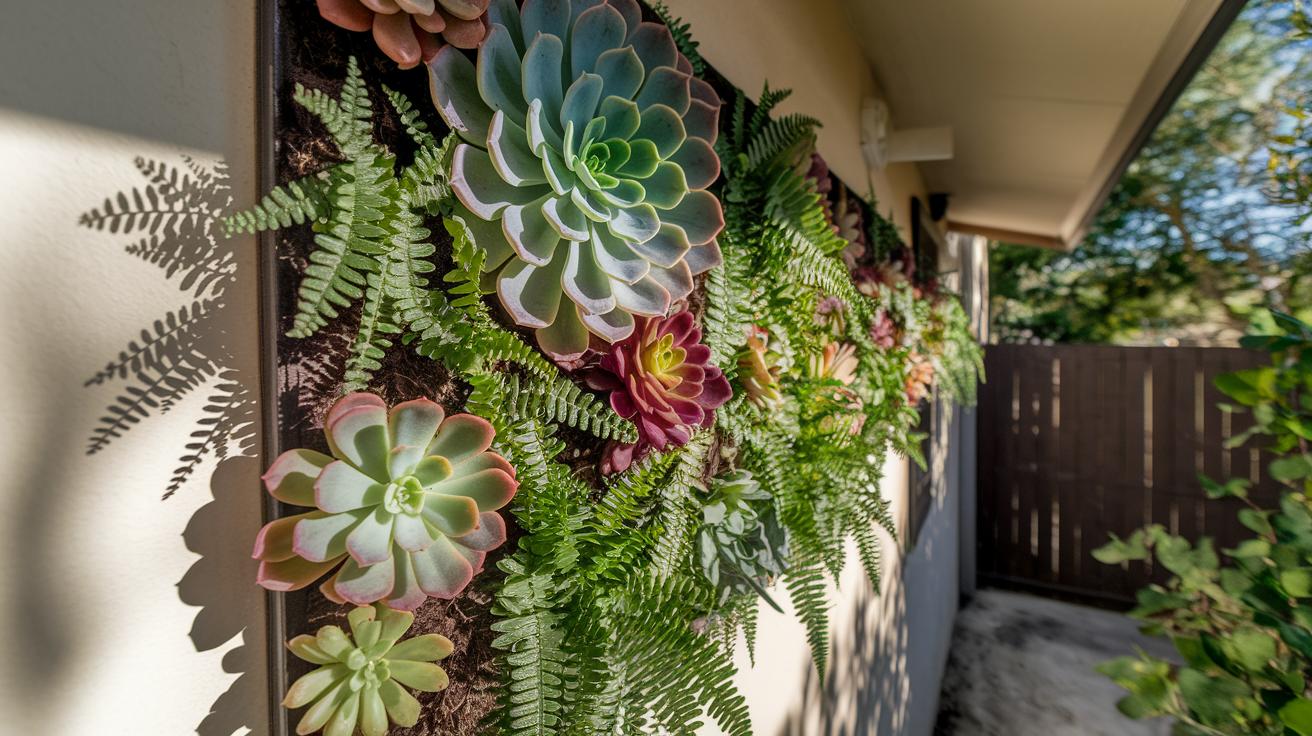
Planting a vertical garden on your patio wall is like giving it a living coat. First, notice how much sun warms your wall and how shade drifts across it. Have you felt that warm afternoon glow?
Here’s a quick guide to plant families and picks:
- Succulents (water-storing plants): sedum, echeveria. These have thick leaves that soak up water so they’re drought-tough.
- Ferns (leafy plants that spread by spores): Boston fern, maidenhair. They have lacy, shade-loving leaves.
- Herbs (cooking greens): basil, mint. Their fresh leaves smell amazing when you chop them!
- Trailers (hanging vines): ivy, pothos. These vines tumble down like a green waterfall.
- Pollinator-friendly blooms: petunias, pansies. Bright flowers that draw bees and butterflies.
Shade lovers like maidenhair fern and moss (tiny green carpet plants) do best on north-facing walls. Take a peek at Choosing Shade Tolerant Plants for Vertical Gardens for more tips. But if your wall catches full sun, go for sun-lovers like succulents, herbs, and trailing petunias.
And here’s a trick: pick compact plants that need less soil and dry out a bit between drinks. Oops, I once gave mine too much water. Wait, I meant underwatered… Then group those with the same thirst together so you’re never guessing who needs a sip.
Planting now sets you up for a lush, snug wall garden.
Comparing Materials and Structures for Patio Wall Vertical Gardens
Picking the right material for your patio wall garden makes a big difference. You want something that looks great, keeps plants snug, and holds up to sun and rain. I’ve tried cedar frames, sleek metal panels, and even recycled pallets. Here’s what each one offers.
-
Weather-resistant wood frames (cedar, redwood)
Wood brings a warm, natural vibe and you can almost smell the fresh grain. The surface feels smooth under your hands. You’ll need to seal it every year or two (that’s adding a waterproof coat to keep rot at bay). It soaks up moisture nicely but adds extra weight to your wall. These frames sit in the mid-price range and last long if you care for them. -
Powder-coated metal vertical green wall panels
These panels have a cool, sleek look that won’t warp or attract bugs. Powder coating (a baked-on paint layer) keeps rust away, even in heavy rain. They stand up to sun without fading. But they do weigh more and you might need to treat cut edges for extra rust protection. Overall, they’re a modern pick for a sturdy green wall. -
Plastic or resin planter boxes
Light as a feather and ready to hang, these boxes hold water well and resist cracking when it freezes. You can move them around on a whim. They cost less but sun exposure can make colors fade over time. Easy choice if you want a low-maintenance setup. -
Felt or fabric pocket systems
Soft pockets feel breezy and let roots breathe. They’re super light and perfect for odd wall shapes. I’ve noticed they dry out faster, so you’ll water more often. After a few seasons, the pockets may need swapping. But they’re fun to rearrange! -
Pallet vertical gardens made from recycled wood
Turning an old pallet into a garden gives you deep soil space and a rustic look. You’re saving wood from the landfill, too. You’ll want to reinforce the slats and add a weatherproof seal. Pallets hold lots of dirt and plants, so make sure your wall can carry the load. It’s a budget-friendly, eco option if you don’t mind some DIY. -
Wall-mounted garden kits with built-in hardware
These all-in-one sets come with brackets, trays, and anchors ready to go. Materials range from plastic to metal, so pick based on the weight you plan to hang (aim for about 25–50 pounds per planter). Installation feels like plug-and-play, even if you’re not a pro. Great for anyone who wants a fast, tidy setup.
Step-by-Step DIY Installation for Patio Wall Vertical Gardens
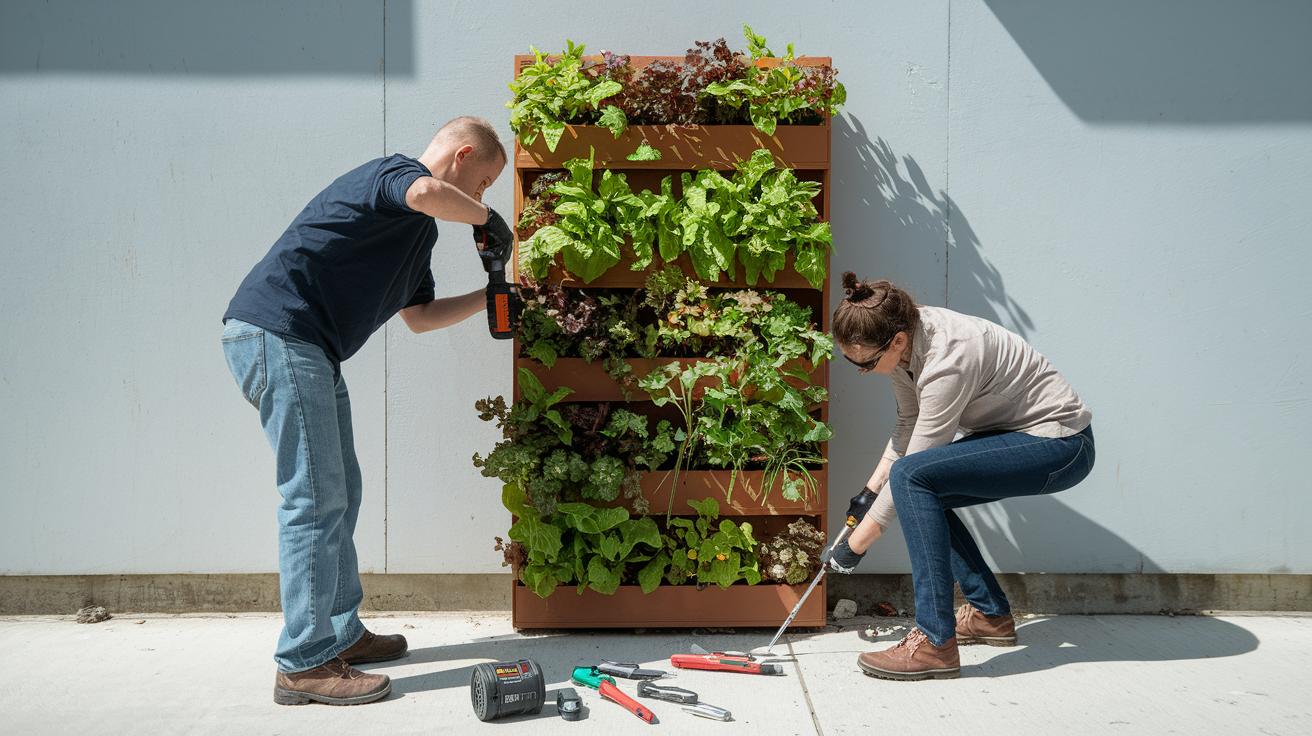
Tools and Materials Needed
- Drill with masonry bit (the bit for drilling into brick or concrete)
- Level and pencil (for marking straight, even lines)
- Stud finder (tool to sense wood beams behind drywall or siding)
- Heavy-duty anchors (hooks rated for 50 plus pounds) and mounting hardware
- Wall-mounted garden panels or racks
- Brackets and screws for holding planters
- Drip irrigation tubing and connectors
- Self-watering planter inserts and drainage trays or liners
Wall Preparation and Mounting
Pick a sturdy wall with plenty of light. Run your hand over it and look for cracks or loose paint. If you spot any, pick a new spot. By the way, my cat once scratched the wall, good thing I checked first.
Use your stud finder to locate wood beams. No beams? That’s okay, we’ll use heavy-duty anchors. Measure and mark each bracket spot, making sure they’re level. Drill pilot holes just a bit smaller than your anchors so they bite in tight. Screw in the anchors, attach the brackets, and give each a gentle tug. It shouldn’t budge.
Line up your panels next. Follow the steps in How to Design a Living Wall for Outdoor Spaces so the pockets stay straight.
Substrate Installation and Irrigation Setup
Grab your planter boxes and line them with a drainage tray or liner. This catches extra water, um, ask me how I know. Clip the drip tubing along the back of each row, then pop the emitters into the soil pockets. If you’re using self-watering inserts, drop them in and thread the fill tube to the top. Twist connectors until they’re snug but not over-tight.
Turn on the system for a quick test. Watch for a gentle drip from each emitter. Adjust flow valves until every pouch gets the same slow trickle. Perfect!
Plant Placement and Initial Care
Sort your plants by sun and thirst. Succulents love full sun, so put them up top. Ferns and moss prefer gentle shade, so tuck them lower. Press each plant’s roots into the soil until they feel snug. Then give everything a good first drink of water. Wait an hour, then check for any dry spots. Oops, missed one? Slide your drip line over and top it off.
Stand back and listen for the soft hum of water feeding your new green wall. You’ve just created a living work of art on your patio!
Irrigation and Maintenance Best Practices for Vertical Garden Walls
Let’s talk about giving your vertical garden wall the TLC it needs. A simple drip irrigation system or a self-watering planter (you can find these for about $20 to $100) will give each pocket a steady, gentle trickle. I love hearing that soft drip in the morning.
Most walls need water 2 or 3 times a week. But if it’s hot or windy, you’ll want to peek at them every day to make sure they’re not thirsty. A clear maintenance schedule keeps your garden humming along.
Here’s a simple routine:
- Watering. Give your wall a good soak 2–3 times a week, either in the early morning or around midday. Adjust if it’s rained or feels extra warm.
- Pruning. Snip off spent leaves and stems once a week. That little trim makes room for new growth.
- Fertilizer. Feed your plants every 4–6 weeks with a balanced liquid feed or slow-release granules (they slowly break down to feed roots).
- Pest check. Take a quick look each month for stray bugs or mildew. Treat spots right away so issues don’t spread.
Seasonal care is key. In cooler months, dial the water back. When summer brings the heat, bump it up. By the way, I once overwatered during an unexpected cold snap, oops, and learned to watch soil moisture like a hawk.
Back to prepping your wall: label each drip line so you know which row you’re checking. Test each emitter (it’s the small nozzle that drips water into soil) once a month to clear any clogs. And don’t forget to flush tubes with fresh water now and then.
Keep a clipboard or a note in your phone with dates for watering, pruning, feeding, and pest checks. Over time, these easy steps help your vertical garden wall thrive year after year.
Affordable Décor & Accent Ideas for Patio Wall Vertical Gardens

Ready to dress up your patio wall without busting your budget? Think of it as adding little surprises among the leaves, soft lights and pops of color. I once hung a strand of lights and felt like magical fireflies danced on my wall.
- String lights (about $15) drape in loose loops. They glow like fireflies when the sun dips below the fence.
- Tiny metal art frames (around $20) peek out between green pockets. They’re lightweight but still grab your attention.
- DIY wooden tags or recycled tin planters ($5–$10 each) let you paint on your own flair. I once got paint splatters all over my gloves, oops.
- Terracotta pots (sunbaked clay pots) or thrifted planters add warm, earthy color. Mix shapes and finishes for extra texture against your foliage.
- Patterned fabric pockets or woven baskets bring in a cozy, handmade feel. It’s like wrapping your plants in a soft quilt, right?
Here’s a simple budget hack: spend $25 on lights, $20 on art accents, and $15 on DIY supplies. That’s only $60 to make your wall pop.
| Item | Budget |
|---|---|
| String lights | $25 |
| Art accents | $20 |
| DIY supplies | $15 |
| Total | $60 |
Clip mason jars to brackets for charming wall-sconce planters (jars that hold small plants). Make plant labels from scrap wood (old boards you’d toss). So easy.
Sustainable and Advanced Systems for Patio Wall Vertical Gardens
I once turned old plastic bottles into planters. I loved rescuing them from the trash. I cut off the bottoms, painted them bright, and hung them in a row on my patio wall. Oops, I even spilled a bit of paint on my shoes.
You can also grab reclaimed wood planks. Seal each board with natural oil. Then fill every pocket with compost (decayed plant bits that feed soil)-rich soil. It feels like blending a green smoothie for your plants.
Think of your soil mix like a sponge. Add moisture-retaining soil (soil mixed with gel beads that hold water). Each plant sips a slow, gentle drink. No more daily watering panic.
If you’re all about cool gadgets, try a hydroponic tower. These stacker columns cost around $100 to $200. A tiny pump pushes nutrient-filled water from a tank up through tubes and drips it back over roots. No soil, no mess. It uses almost 90 percent less water than dirt gardens.
Or give an aeroponic wall a try. Little mist nozzles spray a fine plant-food mist onto roots hanging in air. Your greens get a spa treatment every few minutes.
Finally, tuck slow-release fertilizer pellets into each pocket. They break down over weeks. So you’ll check in less often and your wall stays lush all season.
Final Words
Diving straight into the action, we laid out modular panel ideas, pocket planters and tiered layouts to spark your next project.
Next we handpicked sun-lovers, shade-tolerant greens and trailing vines, matched materials like cedar frames or powder-coated panels, then guided you through each installation step.
We wrapped up with easy irrigation tips, budget décor hacks and sustainable, soil-free options. Your blueprint for vertical garden design for patio walls is ready to go.
Here’s to fresh produce, happy kids and a low-effort backyard you love.
FAQ
What structural approaches work best for a patio wall vertical garden?
The structural approaches for a patio wall vertical garden include modular panels, fabric pocket planters, wooden pallets, and wall-mounted planter boxes that turn a blank wall into a layered, sculptural plant display.
How do geometric layouts, cascading vines, and tiered arrangements improve vertical garden design?
Geometric layouts, cascading vines, and tiered arrangements guide the eye, add depth, and highlight texture contrasts—creating a focal pattern that feels organized yet lush.
Which plants suit different wall exposures in a patio wall garden?
Plant species selection matches wall exposure. North-facing walls suit ferns, mosses, and other shade lovers. South-facing walls fit succulents, herbs, and trailing annuals like petunias for bright color.
What materials make a durable patio wall garden structure?
Durable options include cedar or redwood frames, powder-coated metal panels, plastic or resin boxes, and fabric pocket systems—each balancing natural look, rot resistance, weight, and root breathability.
How do I install a patio wall vertical garden myself?
DIY installation begins with locating studs or using heavy anchors, mounting brackets, attaching panels or boxes, adding drainage trays, setting up drip irrigation or self-watering inserts, then planting by light needs.
What irrigation and maintenance routine keeps a vertical garden healthy?
A healthy routine uses drip lines or self-watering systems for 2–3 weekly waterings, weekly pruning, feeding every 4–6 weeks with balanced liquid feed, and monthly pest inspections.
How can I add sustainable systems to my patio wall garden?
Sustainable upgrades include recycled plastic bottles or reclaimed wood planters, moisture-retentive mix with hydrogel crystals, compost-enriched soil, or small hydroponic/aeroponic setups using 90% less water.


